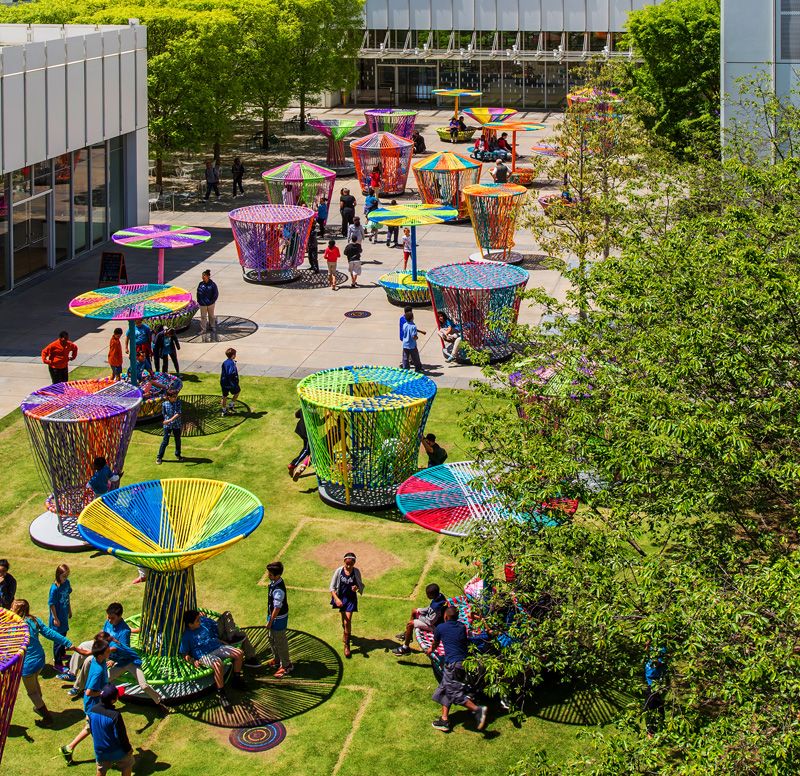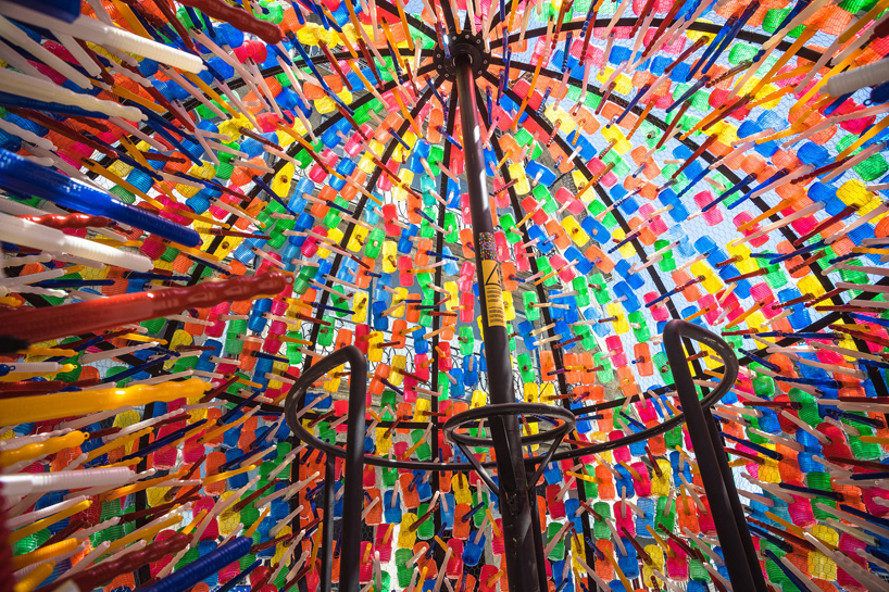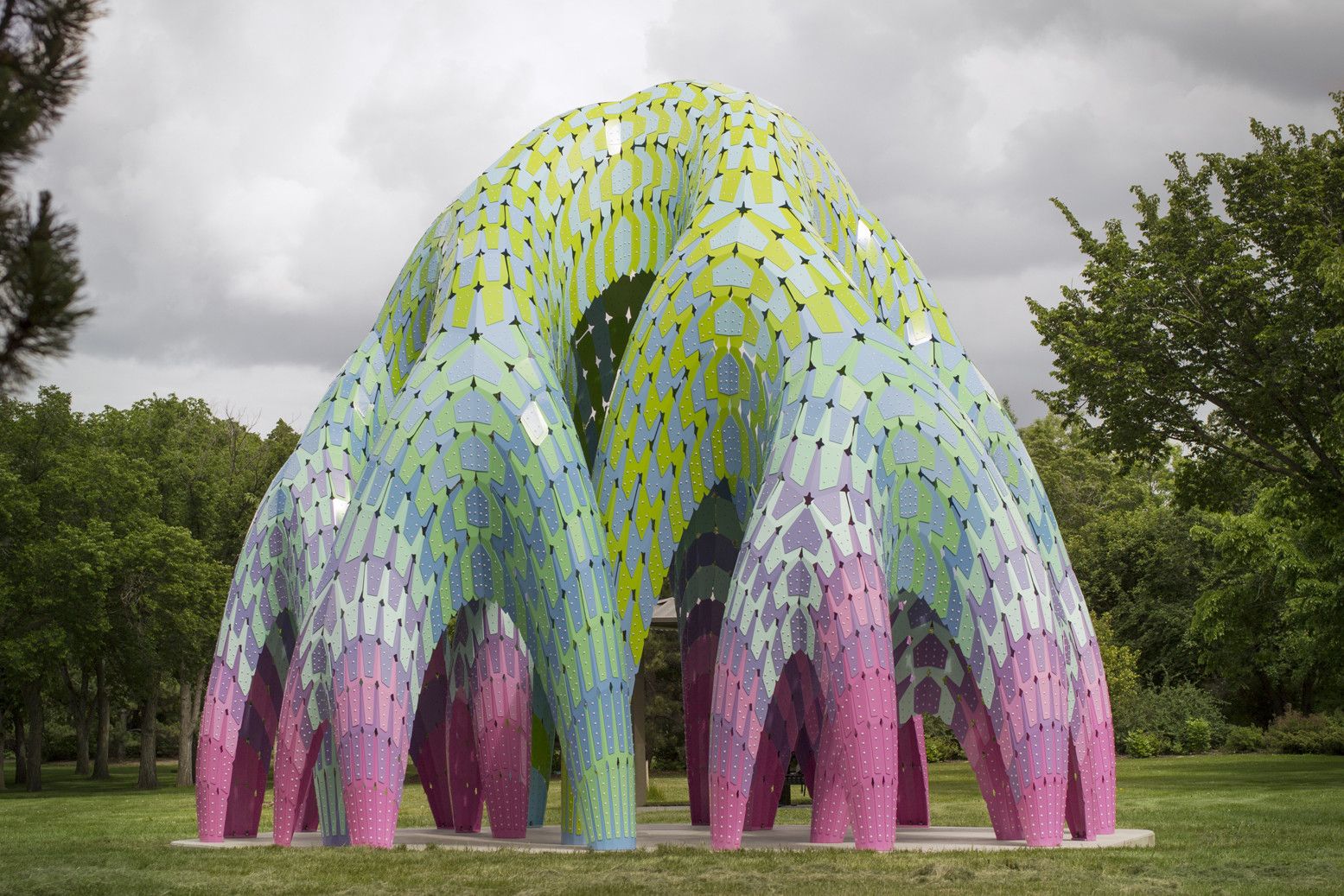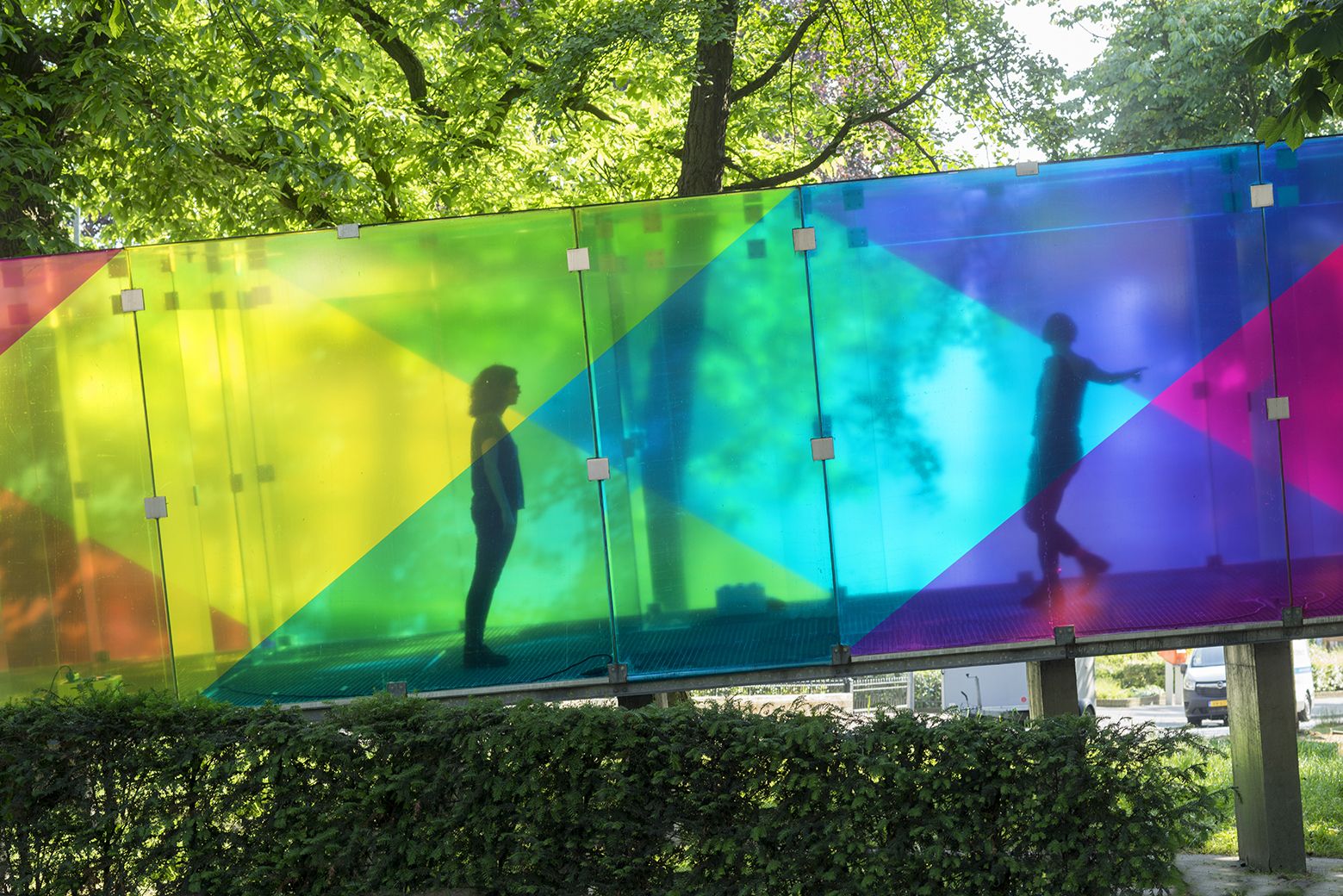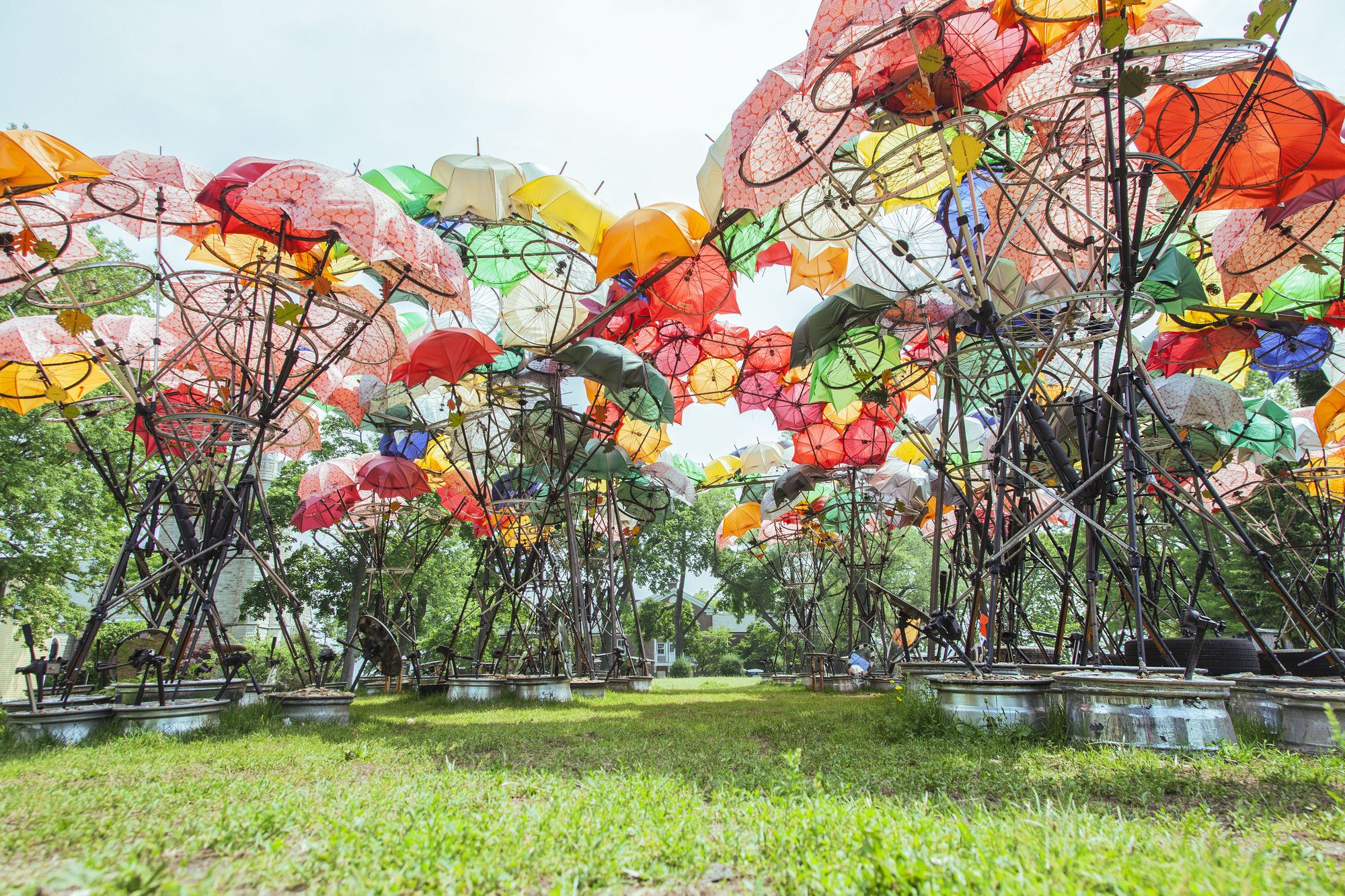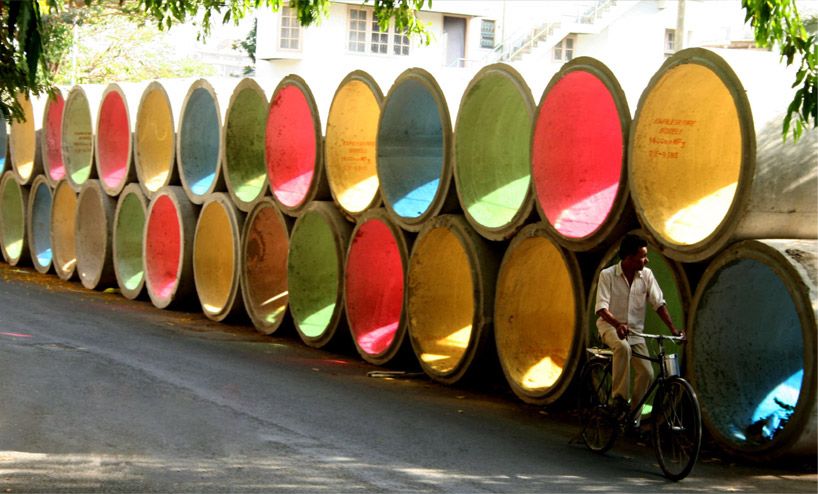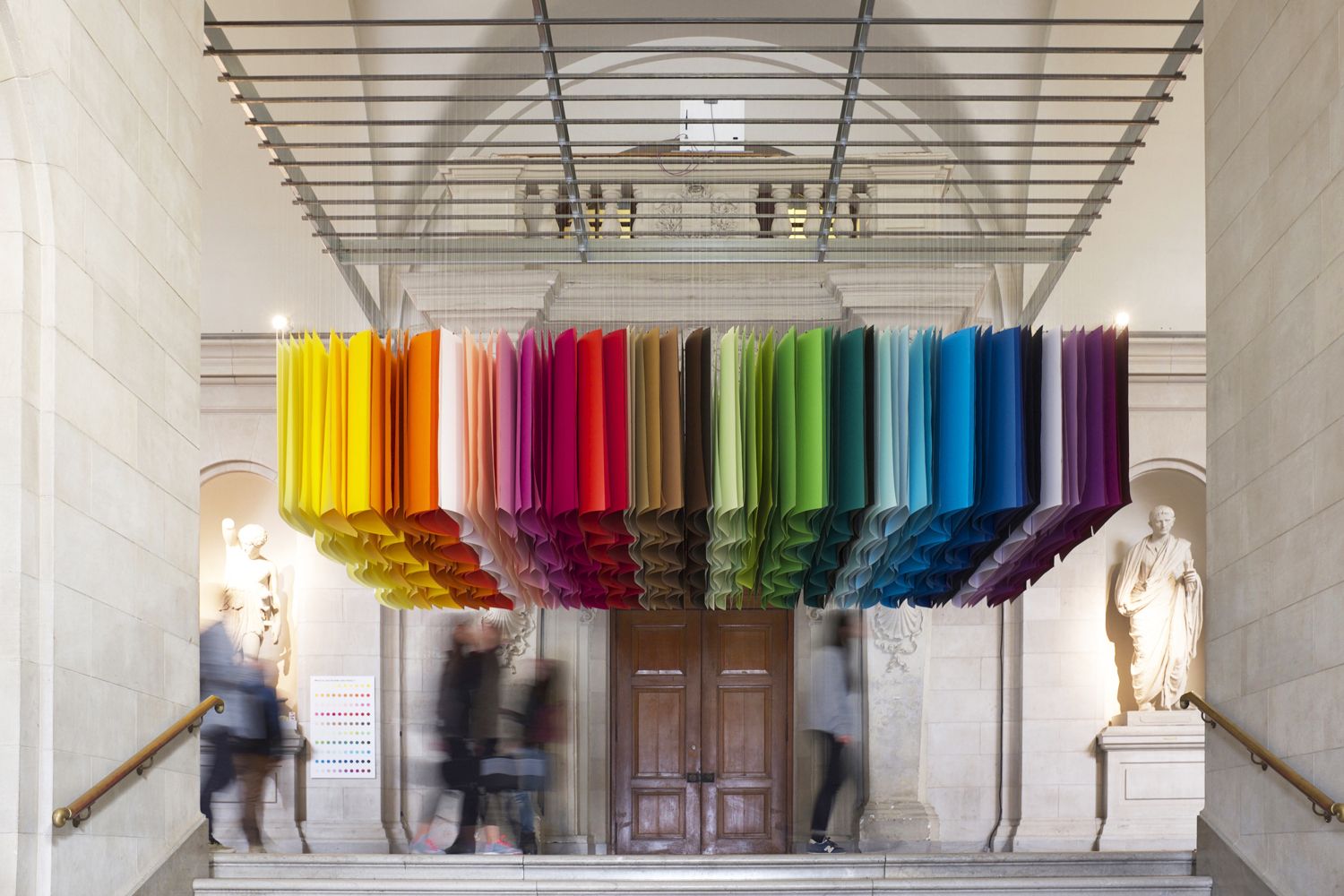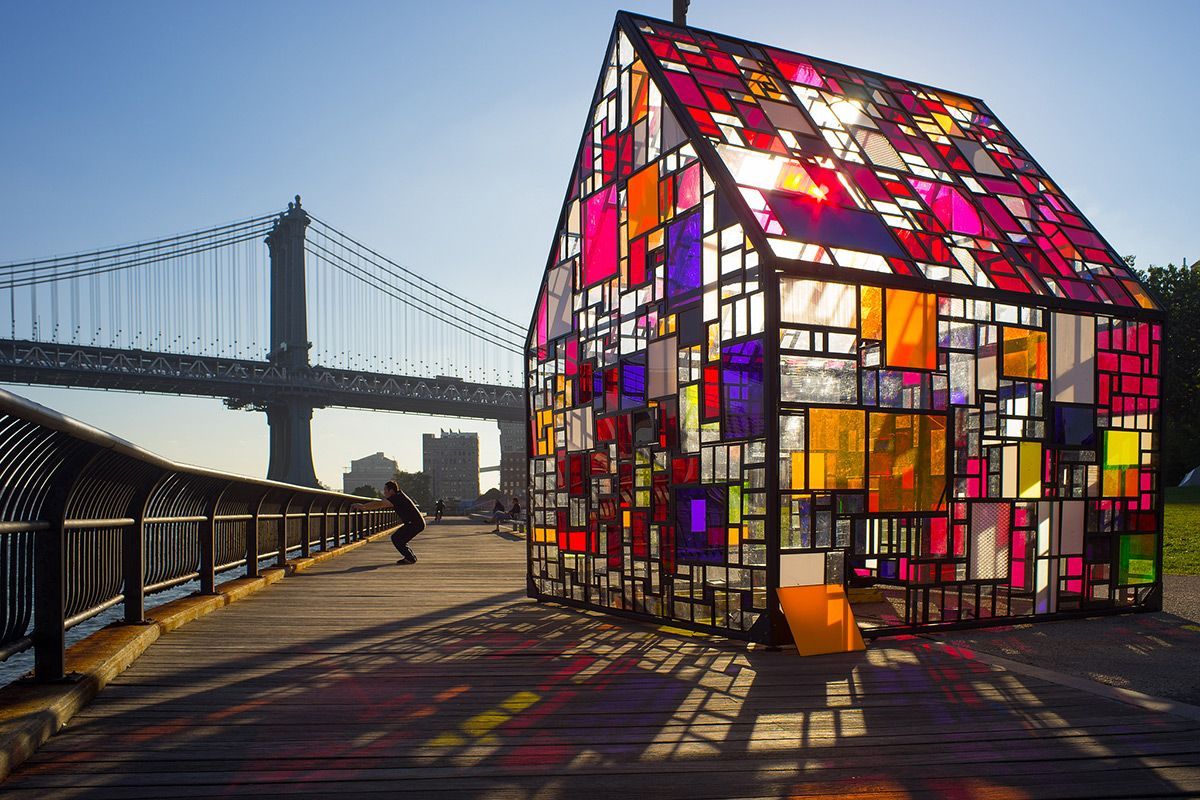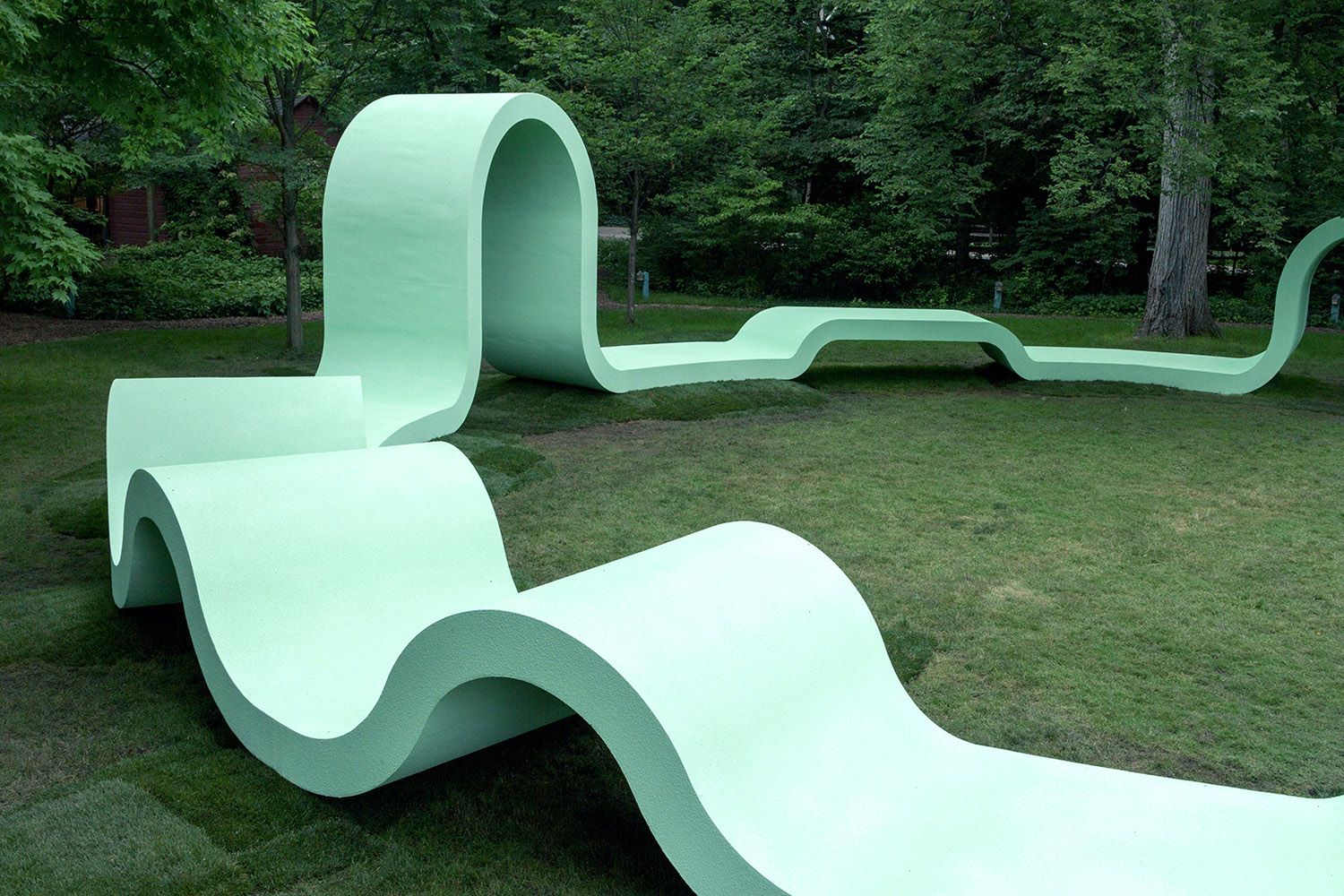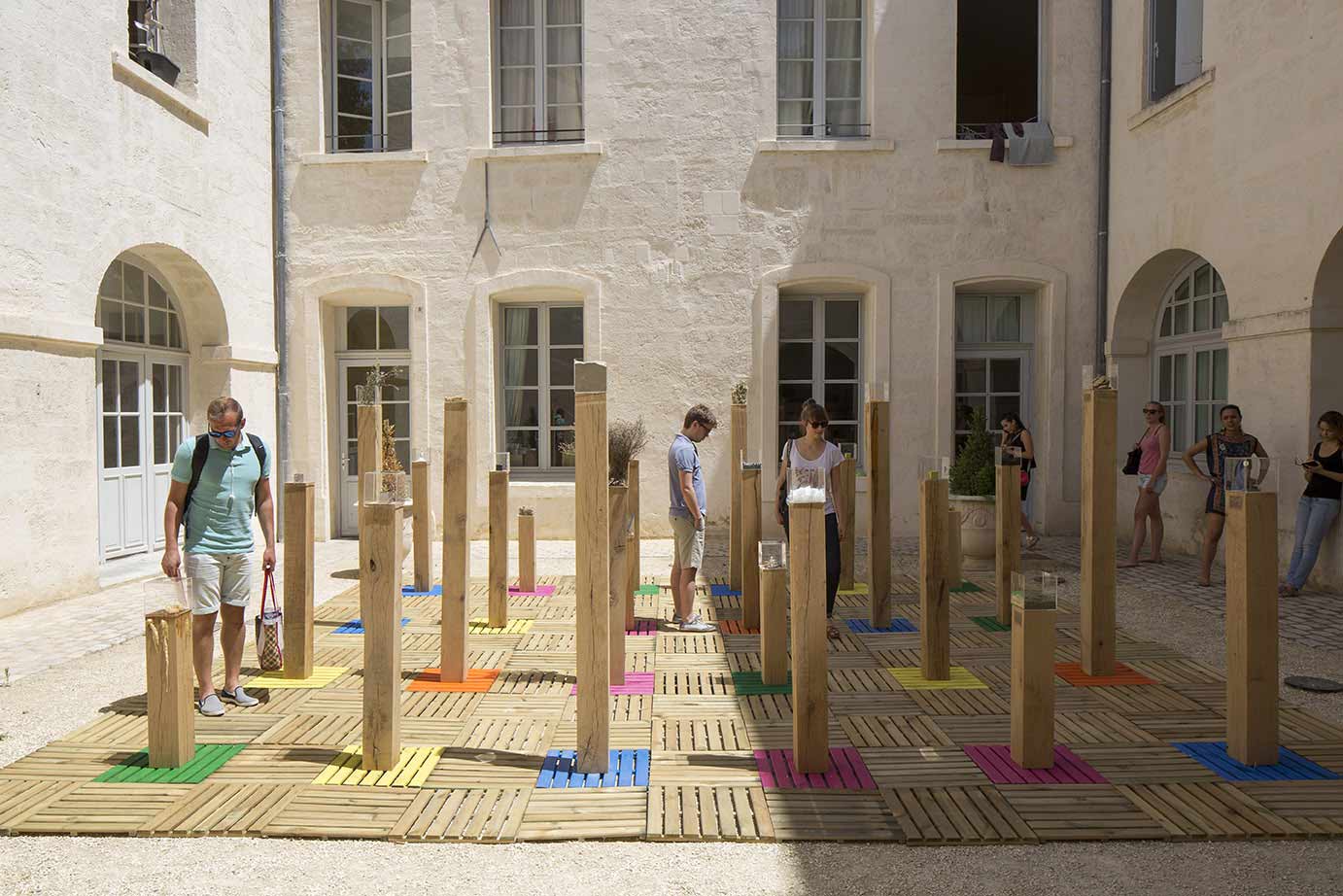As the population moving to live in cities increases annually, whether the right environment to improve the quality of life is provided, remains uncertain. Very few building facades incorporate colorful elements as a contemporary approach to design, but we are all used, now, to gray concrete buildings surrounding our streets and squares and we have gradually lost the inner child in us desiring to feel the vibe of the city and the public space.
Playing used to be in the streets and the open city areas, but we seem to have forgotten that as we grew up. However, there are creative people who are trying to remind us that with some color, the urban landscape can turn into a magical place where miracles still happen. Check these colorful installation artworks that turn gray dull cities into playgrounds.
10 List of Colorful Installation Artworks
1. Los Trompos (Spinning Tops) | Esrawe + Cadena
Mexican designers Héctor Esrawe and Ignacio Cadena, have given a new spin to childhood memories by recreating life-size interactive design installations called Los Trompos (Spinning Tops) in Georgia, Atlanta. These colorful, kinetic pieces are constructed from more than 30 spinning tops, wrapped in multi-hued flat nylon rope. “The concept behind Los Trompos is based on an approach of traditional toys, their colorful expression, and the way they are constructed. We wanted to talk about the traditions and skills of the craftsmen in Mexico, as an inheritance of our culture. We like the idea of translating these techniques into new symbols”, explains Esrawe.
2. GIRA | micro atelier de arquitectura e arte
A sphere made of hundreds of traditional plastic hammers in every color, forming a vibrant multi-colored membrane invites the residents and visitors of Porto to spin in the center of the city. The studio constructed the large GIRA spinning wheel at the center of the city, in celebration of the St John festival which takes place every year on the 23rd of June. The moving installation uses a swivel mechanism that allows users to rotate the structure manually once inside. The collaborative project encourages people to play, interact and enjoy the celebration through active participation. Micro Atelier de Arquitectura e Arte desired to create an interactive piece that would act as an urban landmark within the square and would bring the idea of playing in the city.
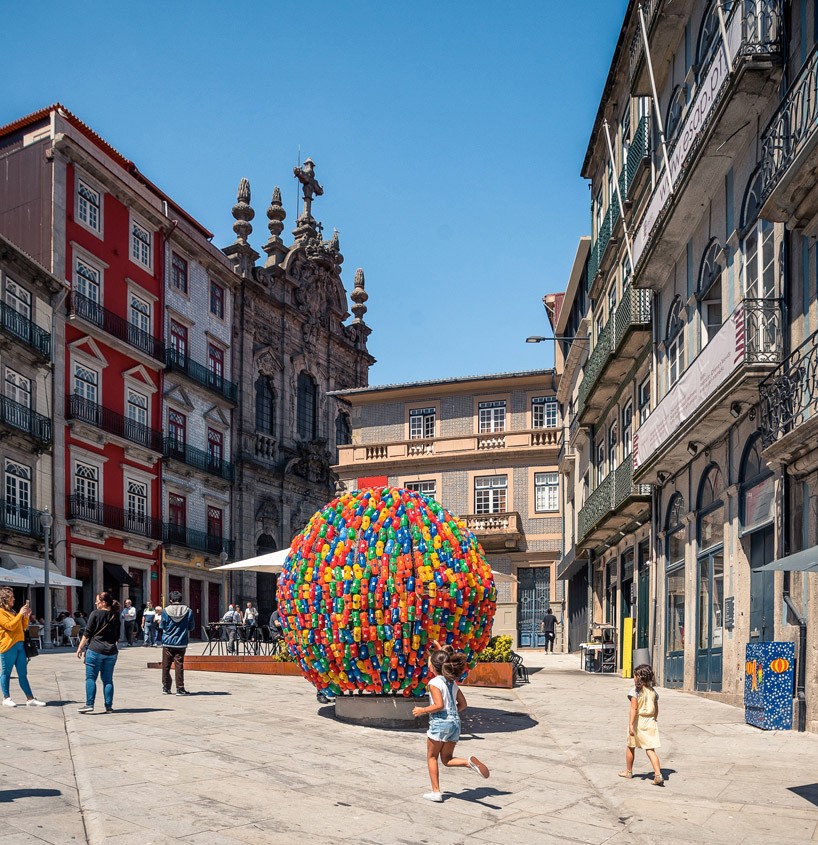
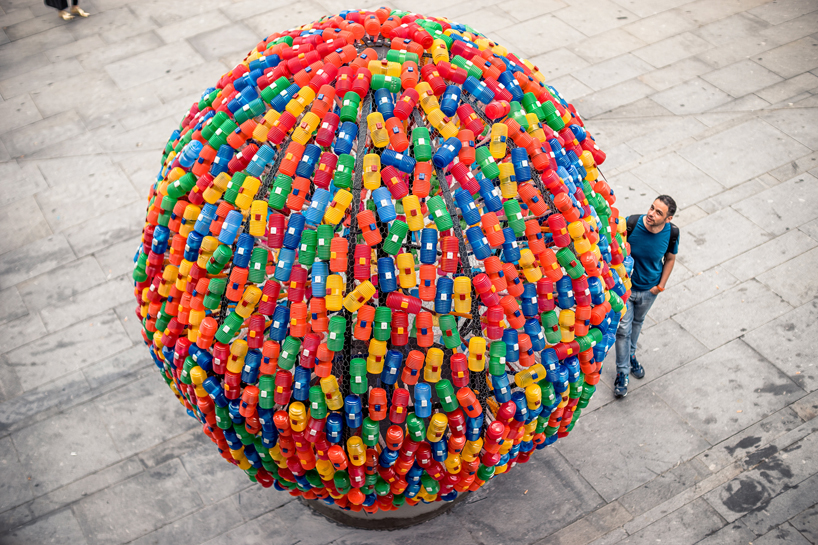
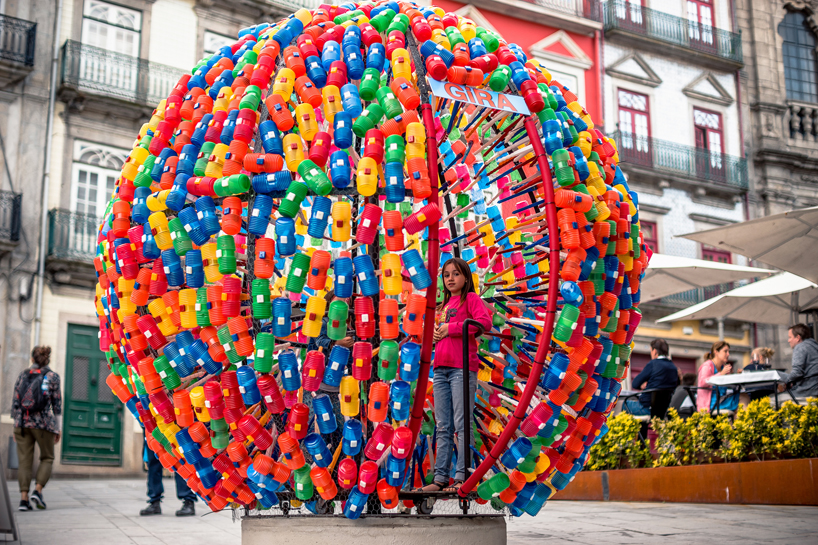
3. Vaulted Willow | Marc Fornes + THEVERYMANY
Located in a public park, Vaulted Willow is an ultra-lightweight architectural folly where form, structure, and ornamentation come together into a unified system. This biomorphic structure is made from digitally fabricated shingles and borrows its color palette from the surrounding landscape. Vaulted Willow is comprised of 721 aluminum stripes, 14,043 connectors, and 60 epoxy concrete anchors. The project uses aluminum of three different thicknesses. 24 base plates are anchored to a concrete pad of 240 cubic feet. It took four days, and a crew of four to assemble the prefabricated parts.
4. CMY Pavilion | Shift
Shift’s intervention in the famous Tschumi Pavilion reinterprets the idea of “unstable facades”, by injecting shots of color in the glass building while retaining its transparency. Covered with angled stripes of cyan, magenta, and yellow film, the pavilion becomes a three-dimensional graphic that changes as visitors move through and around. People circulating on the roundabout will experience continuously changing colors and patterns. Internally, colors mix with the city, and the palette remains in its three-color layout. The films are wrapped diagonally around the structure to enhance the destabilized, gyrated effect that Tschumi created through tilting the building.
5. Organic Growth Pavilion | Izaskun Chinchilla
The Organic Growth Pavilion is predicated on two simple, yet profound, ideas: adopt architectural and structural principles from the morphology of adaptive plants and organisms, and source all components from secondhand and recycled materials. The proposed design employs commonly found materials, giving them a new life after they have become unfit for their original purpose. Structural framing is consisted of used umbrellas, stools, and tripods while it is inspired by nature and more specifically by the morphology of the hydrangea. Shading devices were built out of umbrella tops and recycled bicycle wheels.
6. Storm Water Pipes | Urfun Lab
By simply taking colored cellophane and fashioning it to one side of each pipe, the creatives at Urfun Lab have created a makeshift kaleidoscope of colorful forms that transform an unsightly concrete roadside pile into an unexpected public space. Stormwater pipes have become a common sight throughout cities across India, and they remain in prominent view until they are installed below ground. By adding a coat of color to one side of the pipe, Urfun Lab caused them to catch sunlight and cast an array of patterns on the roadside throughout the day. The pipes even provide a new place to hang out and rest. “It is meant to be a symbolic gesture on how to respond to our immediate environment”, say the architects.
7. 100 Colors no.3 | Emmanuelle Moureaux
As a first outdoor installation, Emmanuelle Moureaux has transformed the space in Shinjuku Central Park in Tokyo using the full spectrum of floating colors. Having high-rise buildings in the background, the 1875 hand-dyed textile strands create a dynamic motion that encourages the entirety of the work to capture light breezes and sway in the wind. Floating colors in the sky of Shinjuku is a breathtaking installation that has given people a little moment to stop by, away from the busy reality.
8. Stained Glass House | Tom Fruin
Tom Fruin is an artist known for his talent in converting reclaimed materials into brilliant art installations. As part of the DUMBO Arts Festival, the artist installed his famous plexiglass house, Kolonihavehus, in Brooklyn Bridge Park. The multi-colored house was lit from inside and temporarily inhabited by performance duo CoreAct who engaged in a collaborative physical performance. After the end of the festival, the installation remained in situ for visitors and citizens to enjoy the colorful plays of light.
9. Rounds | SPORTS
Rounds is a temporary plywood theater pavilion created for an artist colony in the north of Chicago. The installation is an undulating arching ribbon creating a perfect 70-foot diameter circle in the plan. Nestled in a clearing in the forested front of the estate, the piece ties into its surroundings with curving archways. The arches rise to different heights, forming varied elevated seating areas, passages to the center, and one large space designated for a stage. Each arch responds to different conditions around the site, such as the main house, the residency building, or an entry path. The mint green color is vibrant, yet complementary to its verdant surroundings.
10. Colibri | Reset Studio
The innovative methodology of Jae Young combined with the revolutionary conceptual design of Julien give rise to an architecture office motivated by a common vision: each project constitutes a unique concept on an urban, environmental, sociological, and cultural level. Through the reflection of the spatial materiality and invisible architecture, the projects of Reset Studio are the results of rethinking the social interaction between buildings. Colibri consists of 24 local artifacts, including rare flowers, sand, olive oil, placed on top of wooden pillars on a colorful deck. Visitors were invited to move among pedestals, taking in the sights, smells, and textures of the local culture.


